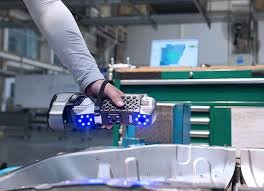The Role of 3D Scanning in Driving Industrial Innovation

In today’s fast-paced world, technological innovation is at the forefront of industrial growth. One such technology that is revolutionizing the way businesses operate is 3D scanning. This tool helps companies make accurate digital models of real objects.
If you’re a business owner or curious about technology, 3D scanning’s impact will interest you.
Understanding 3D Scanning
3D scanning captures an object’s physical size and turns it into a digital format. This process uses special devices that shine laser beams on the object.
They measure distances as the laser bounces back. The data collected is used to form a detailed three-dimensional representation.
These models can be incredibly accurate, often achieving precision down to the millimeter. This level of detail ensures that any modifications or new designs based on the scans will be exact and reliable. This technology helps businesses reduce mistakes from human error in old measuring methods.
The Importance of Design Accuracy
For businesses, having access to detailed and accurate designs is crucial. If product components do not fit together perfectly, it can lead to costly mistakes. Whether it’s in manufacturing, product design, or even architectural projects, precision is key.
3D scanning boosts design accuracy. It gives an exact image of existing objects. Designers can use this to create new designs or improve old ones.
Companies that utilize this technology can identify flaws that might otherwise go unnoticed. This not only saves time and resources but also ensures high-quality outputs that meet consumer standards.
Applications of 3D Scanning in Industry
The applications of 3D scanning are vast and varied across many industries. Here’s a closer look at how various sectors gain from this new technology:
Manufacturing
In manufacturing, precision is everything. With 3D scanning, companies can make prototypes fast and accurately. If a company makes parts for an aircraft, even a tiny flaw can cause big safety problems. 3D scanning helps ensure that every piece meets stringent safety standards.
Aerospace and Automotive
Industries such as aerospace and automotive are known for their complex designs. 3D scanning allows these industries to analyze every detail of parts and assemblies.
A vehicle’s component can be scanned to confirm it fits within tolerance levels. If not, changes can be made before manufacturing starts. This helps avoid expensive fixes later.
Architecture
In architecture, 3D scanning helps architects get an accurate representation of existing structures. This process helps with renovations and restorations.
It gives a clear view of what exists. It saves time and cuts measurement errors. Builders can see how new designs fit in a space.
Healthcare
Even in healthcare, 3D scanning is making waves. Medical professionals use it to make custom prosthetics and dental fittings for each patient.
This customization boosts comfort and functionality. As a result, it can greatly enhance a patient’s quality of life.
Benefits of 3D Scanning for Businesses
Implementing 3D scanning technology brings numerous benefits that can enhance operational efficiency. Here are some of the key advantages:
Enhanced Accuracy
3D scanning helps businesses cut down on human error in measurements. The data it collects is much more precise.
Faster Prototyping
Companies can create prototypes much quicker than in traditional methods. This speed can give businesses a competitive edge in their respective markets.
Cost-Effective Solutions
The upfront cost of 3D scanning technology may seem steep. However, the long-term savings from fewer errors and less need for redesigns can more than make up for it.
Seamless Workflow Integration
3D scanning works well with other digital manufacturing tools. This creates a smoother and more efficient workflow.
Improved Quality Control
Businesses can use 3D scanning for quality inspections. This helps them ensure that parts and products meet precise specifications. This leads to fewer defects, higher customer satisfaction, and compliance with industry standards.
Better Reverse Engineering
3D scanning lets companies make copies of products or parts. They can do this even without the original design files.
This is especially useful in industries like automotive, aerospace, and manufacturing. Here, legacy components often need replacement or modification.
Enhanced Customization
Industries such as healthcare, fashion, and consumer goods use 3D scanning. This technology helps them create personalized products. You can make custom prosthetics, tailored clothing, and unique products with high precision.
Time-Saving in Construction and Architecture
Architects and construction firms use 3D scanning to capture site conditions accurately. This helps plan projects faster. It cuts down on rework. It also boosts teamwork among groups.
Real-World Case Studies
To better understand the role of 3D scanning in driving industrial innovation, let’s look at a few real-world examples. One notable case is an automotive company that adopted 3D scanning to redesign a car model.
Designers scanned the current vehicle to find ways to improve aerodynamics. This led to a new model that surpassed fuel efficiency standards.
In healthcare, dental professionals use 3D scanners like the EinScan Libre. They create accurate dental molds for patients. This advancement saves time on fittings and boosts patient satisfaction with custom solutions.
The Future of 3D Scanning
As technology continues to advance, so does the field of 3D scanning. AI and machine learning will likely boost the abilities of 3D scanners. These advancements will likely lead to even more precise scans and faster processing times.
As businesses move to digital solutions, the need for quality scanning will rise. This means companies that adopt 3D scanning today will be at the forefront of innovation tomorrow.
Challenges of Implementing 3D Scanning
3D scanning technology has many benefits. But businesses also face challenges when trying to use it.
One key challenge is the initial cost, which can be a barrier for smaller companies. The long-term savings are big, but the upfront costs can stop some businesses from using 3D technology.
Another challenge is the need for skilled operators. To get the most from 3D scanning, companies should train their staff to use these tools well. This investment in human resources is crucial for realizing the full potential of 3D scanning technology.
Embracing the Future of Industrial Innovation
3D scanning is making a profound impact across various industries. With its ability to enhance design accuracy and streamline processes, businesses that leverage this technology stand to gain a competitive advantage.
Using 3D scanning creates new opportunities. Businesses can innovate and enhance their practices. The future belongs to those who adapt and embrace such transformational technologies.
If you enjoyed this article and would like to read more like it, please check out the rest of our blog today.





